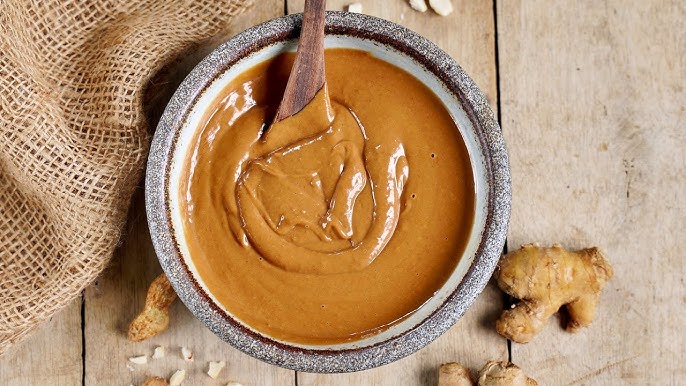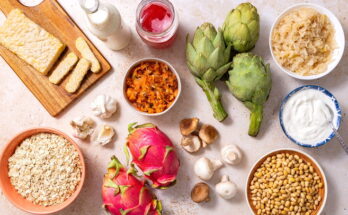Peanut Sauce Recipe: Peanut sauce is a rich, creamy, and versatile condiment that adds a burst of flavor to any dish.
It originated in Southeast Asia, particularly Indonesia, where it is known as “satay sauce.” Over time, it has become a staple worldwide, celebrated for its nutty, sweet, and tangy flavor.
Whether you’re using it as a dip for spring rolls, a dressing for salads, or a topping for noodles, peanut sauce is a must-have in any kitchen.
Ingredients for Peanut Sauce
To make a classic peanut sauce, you’ll need:
- 1/2 cup peanut butter (smooth or chunky, as per preference)
- 1/4 cup soy sauce (low sodium is recommended)
- 1/4 cup coconut milk (or water for a lighter version)
- 2 tbsp rice vinegar (or lime juice)
- 2 tbsp brown sugar (or honey)
- 1 tbsp sesame oil (optional but adds depth)
- 2 cloves garlic (minced or grated)
- 1 tsp grated ginger (fresh is best)
- 1-2 tsp chili paste or sriracha (for spice, optional)
Substitutions:
- Peanut butter can be replaced with almond or cashew butter for a unique flavor.
- For a soy-free version, use coconut aminos.
- Brown sugar can be substituted with maple syrup for a healthier option.
Tools Needed
- Mixing bowl: For combining ingredients.
- Whisk: Ensures smooth blending.
- Measuring cups and spoons: For accuracy.
- Microplane or grater: For garlic and ginger.
Optional:
- Blender or food processor for ultra-smooth consistency.
Step-by-Step Instructions
Step 1: Preparing the Ingredients
Start by gathering all the ingredients listed. Measure them accurately and chop or grate fresh garlic and ginger. This prep work makes the process smoother and ensures consistent flavor.
Step 2: Mixing the Sauce Base
In a mixing bowl, combine the peanut butter, soy sauce, coconut milk, rice vinegar, and brown sugar. Stir gently with a whisk to start dissolving the peanut butter. The mixture might look lumpy initially, but keep stirring!
Step 3: Adjusting the Consistency
Gradually add water (1 tablespoon at a time) if the sauce is too thick. Aim for a creamy, pourable texture. If you’re using it as a dip, leave it thicker. For a salad dressing, make it slightly runnier.
Step 4: Final Touches for Flavor
Add the sesame oil, garlic, ginger, and chili paste or sriracha for extra heat. Taste the sauce and adjust the sweetness, saltiness, or spiciness to your liking. If it feels too strong, a splash of water or coconut milk can mellow it out.
Serving Suggestions
Peanut sauce is incredibly versatile! Try these ideas:
- As a dip: Perfect for fresh vegetable sticks, grilled chicken skewers, or spring rolls.
- With noodles: Toss it with cooked noodles and veggies for a quick, satisfying meal.
- Salad dressing: Drizzle over mixed greens, cucumbers, and carrots for an Asian-inspired salad.
- For rice dishes: Add it as a topping for rice bowls with tofu or chicken.
Customizing the Peanut Sauce
Make it Spicy: Add more chili paste, sriracha, or even a pinch of cayenne pepper.
Sweetness or Saltiness: Adjust with sugar or soy sauce as per your taste.
Dietary Variations:
- For a low-carb version, skip the sugar and use a sugar substitute.
- To make it vegan, ensure all ingredients, especially the sugar, are plant-based.
Health Benefits of Peanut Sauce
Peanut sauce is not just tasty but also packs a nutritional punch:
- Healthy fats: Peanut butter is rich in monounsaturated fats, good for heart health.
- Protein: Makes it a great addition to vegetarian meals.
- Vitamins: Ginger and garlic offer immune-boosting properties.
Want to make it healthier? Use natural peanut butter with no added sugar or oils.
Storing and Reusing Peanut Sauce
Store leftover peanut sauce in an airtight container in the refrigerator for up to 7 days. Before using, reheat it gently in a microwave or on the stovetop, adding a splash of water if it thickens. Avoid freezing, as the sauce might separate upon thawing.
Tips for Perfect Peanut Sauce
Balance is key: Aim for a harmonious blend of salty, sweet, and tangy flavors.
Don’t overmix: Over-whisking can make the sauce too thick.
Taste as you go: Adjust flavors gradually.
FAQs about Peanut Sauce Recipe
1. What are the main ingredients for peanut sauce?
Peanut sauce typically includes peanut butter, soy sauce, garlic, ginger, lime juice, and a sweetener like honey or brown sugar. Some recipes may also add coconut milk for a creamy texture.
2. Is peanut sauce spicy?
Peanut sauce can be adjusted to suit your spice preference. Adding chili flakes, sriracha, or Thai red curry paste will make it spicy, but you can omit these for a milder version.
3. How long does peanut sauce last?
Homemade peanut sauce can be stored in an airtight container in the refrigerator for up to one week. Make sure to stir it before use as it may thicken over time.
4. Can I make peanut sauce without soy sauce?
Yes! For a soy-free version, you can substitute coconut aminos or tamari for soy sauce. Alternatively, a pinch of salt can work as a simpler replacement.
5. What dishes go well with peanut sauce?
Peanut sauce is perfect for dipping spring rolls, drizzling over grilled meats, tossing with noodles, or serving as a salad dressing. It also complements roasted vegetables and rice bowls beautifully.
6. Can I make peanut sauce nut-free?
Absolutely. You can replace peanut butter with sunflower seed butter or tahini to create a nut-free alternative that retains a similar creamy and flavorful profile.
Conclusion
Peanut sauce is a culinary gem, offering endless possibilities for creativity in the kitchen. By making it at home, you can customize the flavors to your liking and enjoy a fresh, preservative-free condiment that’s far superior to store-bought options. Whether you’re preparing a quick snack or an elaborate meal, peanut sauce has got your back.



